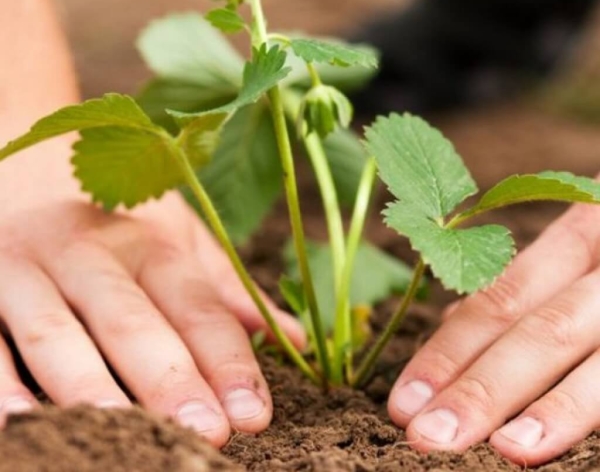Growing strawberries in the country has long become a tradition. The development of a new territory near the house usually begins with the planning and distribution of the best sites between your favorite cultures.
By all the rules, strawberries are allocated the sunniest place.. Even a slight shadow does not affect the better for fruiting garden large-fruited strawberries, or strawberries - as they used to call it.
Table of contents
When is it better to plant garden strawberries - in spring or autumn?
It may seem strange, but strawberry is an evergreen plant, it does not have a rest period. Growth continues under the snow, but not as fast as in the spring.
Almost strawberries can be planted at any time of the year - the bush will not die.
So it is permissible to reason in two cases:
- urgently need to determine the seedlings on the bed;
- an opportunity to master the new site.
Planted in an unfortunate time, strawberries will surely survive. It may even bloom and give berries. But their quality and quantity will make one doubt either the planted variety or his talent as a gardener.
Their number is associated with the general development of the bush, the state of the roots and nutrition in the second half of the year.
Strawberry planted in spring take full advantage of the stock of melt water and by August will form a powerful plant, but flower buds (even if they were) will give few berries.All the forces of the plant were directed to acclimatization in a new place.
Positive moment - powerful bush "Victoria" with large leaves over the summer synthesizes a lot of nutrients. These sugars are not only deposited in the false stem (the so-called "horns"), but also allow the plant to form fruit buds. In other words, you are laying the harvest for the next year.
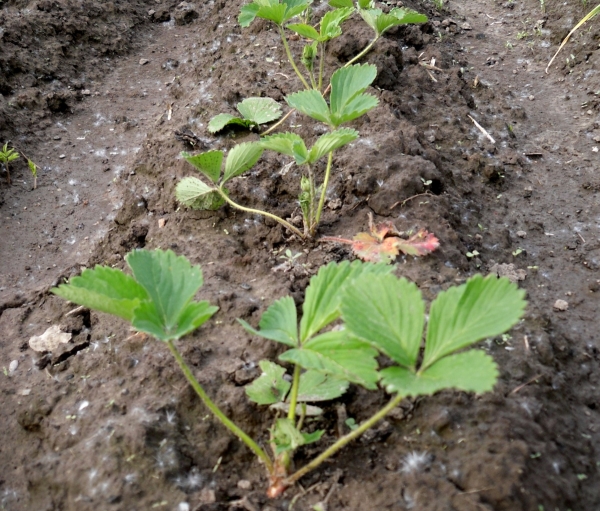
In the second half of summer, strawberries usually have time to form a mustache with rosettes of new plants — high-quality planting material.
Usually for breeding varieties use the first two sockets. - they give the most powerful and productive strawberry bushes. Extreme sockets can also be planted, but they are stunted.
This planting material is used only with a lack of seedlings, they require more thorough care and increased attention after transplantation.
Advantages and disadvantages of planting in August and autumn
Important advantages planting strawberries in autumn:
- availability of quality planting material;
- usually at the end of the summer part of the beds is vacated;
- strawberry seedlings have time to settle well in a new place.
Autumn planting berry bushes and has a disadvantage. The end of summer in the continental climate is usually a dry and hot period. To plant planted normally rooted, it is necessary to control the situation.
Until the new leaves grow, the strawberries have not yet taken root. The whole period of time before this requires careful care (this is about two weeks):
- watering (only deep, otherwise the roots will remain on the surface, and the bush will constantly suffer from lack of water);
- loosening between the rows (it is necessary not only to save water, but also to deliver air oxygen to the growing roots).
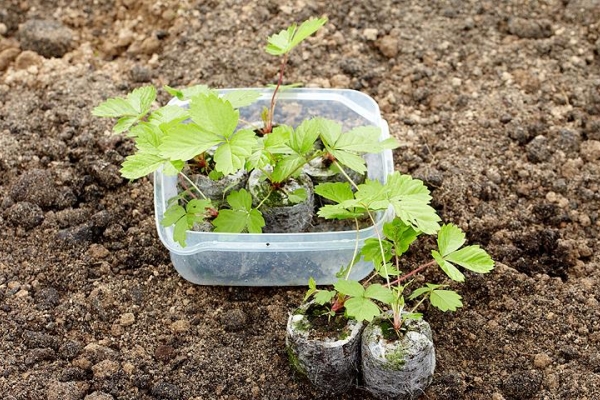
Choosing a good place to grow
First of all, you need to prepare a bed to plant strawberries:
- Given that its root system penetrates a maximum of 20-25 centimeters, the site must be dug up on the bayonet of a shovel.
- It is very important to remove the rhizomes of perennial weeds as far as possible.
- If the site is wet, it is better to immediately organize "high beds" or at least plant on the ridges.
These preparatory operations for laying strawberry beds will save you from the "extra" work for at least two or three seasons.
Strawberries are best planted in narrow stripes oriented south-north. - With this arrangement, the plants are illuminated by the sun evenly throughout the day.
If your site is located on a slope, the rows should be placed only along the slope (no transverse rows - the very first shower will wash off your landings).
Shrubs best planted and transplanted about 25 centimeters apart. If the seedlings are weak - you can plant two seedlings in one hole.
Workshop on planting strawberries in the fall:
How and where to plant seedlings: stages, terms and more
The most important thing is to plant the bushes so that they grow as fast as possible. Then by the winter they will still have time not only to put off the supply of nutrients, but also to lay flower buds for the next season.
Nothing will work out if the bush of strawberries is planted with deepening or, on the contrary, too high.Such bushes will significantly lag behind in development and, most likely, will not bloom.
Seedlings preparation
Most often, purchased seedlings go a long way until they get to the garden. Before planting, they must be reanimated. - put in water to restore the state of the roots.
You can add to the water stimulants rooting:
- preparations of the type of heteroauxin, "Cornevina", succinic acid;
- a teaspoon of honey;
- crushed leaf of aloe.
For better survival leave on a bush only 2-3 leaves. Here, the manifestation of pity is unjustified - through the surface of the leaf, the plant only loses water, which the roots are not yet able to deliver to the bush.
These seedlings will take root with big problems and get sick for a long time.
The stubs should also not be too long. If they are shortened to 5-6 cm, they will even recover faster. Young roots contribute to the growth of the bush and its accelerated development.
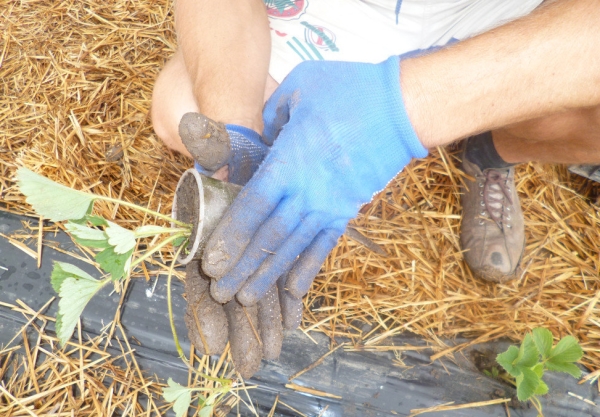
Location selection
Strawberries can grow almost on sand and clay, they are not afraid of drought and can soak soaking roots, but you can’t wait in the shade of normal berries.
If the first three problems can almost be solved, then garden strawberries planted in the shade please you first powerful bushes with huge leaves, and then a small amount of very sour berries (also - larger than usual), prone to all sorts of rot.
The garden strawberry is the most formidable enemy - the larva of the May beetle. Gardeners themselves often provoke its appearance on the site. From the best of intentions, in the struggle for an eco-friendly berry, they uncontrollably fertilize the beds with humus.
During the spring summer, the female beetles lay eggs right in the fertilized beds. And the larva lives in the ground up to 4 years of age and is able to gnaw through the root of an apple-tree 5-year-old, not like strawberry.
When preparing the soil for garden strawberries, it is necessary to take this into account - chemical agents against the larvae are ineffective, since they live in a layer of earth up to 1 meter.
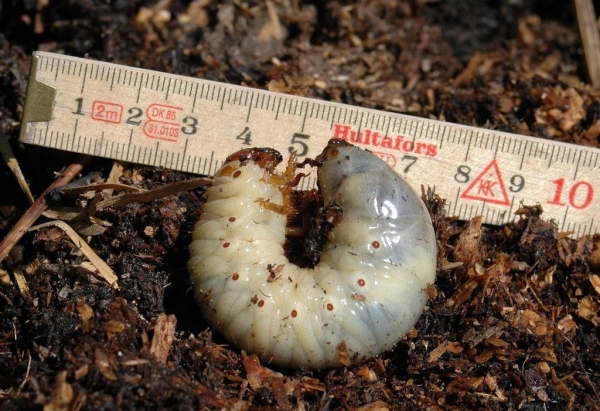
It must be remembered that strawberry beds still have to winter. Who does not want to take shelter of strawberries for the winter, should take care of this in advance.
The best frost protection is snow.. Without shelter, strawberry bushes survive through -20 degrees and short-term drops to -25-30 degrees of frost (depending on the variety) without damage.
Snow cover even 15-20 centimeters can reliably cover a strawberry bed even from frost -30-35 degrees. Everyone knows where a steady snow cover usually lies in winter. There must grow strawberries.
You can sit down!
If no pre-fertilizers have been added to the garden bed, it is better to carry out all top dressing after, when the seedlings are already growing.
If you do not dig holes for each seedling, you can organize the work so that a maximum of an hour you can plant up to 200 strawberry bushes.
- Mark with laces on pegs rows.
- By marking conduct a groove depth of approximately 10-15 centimeters.
- Spill the rows with water.
- If there is ash - sprinkle in rows.
- Spread out seedlings at a distance of about 25 centimeters from each other.
- Sprinkle the roots of the seedlings to half ground.
- Water these half-buried roots.
- Dry ground to the outlet to fill the groove.
All - the bed is ready. After such a planting can not water for 2-3 days. Dry land will play the role of mulch.

Care after transplanting and harvesting
There is only one thing in common with transplanted and otter-bearing strawberries (after picking berries): these bushes need a “shape recovery”. For this, foliar dressings are carried out with a complex fertilizer for berries.
Their advantage over root nutrition - substances are absorbed by the leaves within a couple of hours and quickly begin to act.
However transplanted strawberries need not only potash and phosphate dressing. She needs to have time to maximize the mass of the bush to stock up on nutrients of photosynthesis products for the winter.
Nitrogen supplements after September strawberry benefits will not bring. The introduction of phosphorus is vital in the autumn dressing - the development of the root system depends on its presence.
Watering and strawberry fertilizer:
How to transplant?
If it was necessary to transplant garden strawberries within one site, this can be done completely without harm to the plants:
- On the eve it is necessary to conduct high-quality watering (if the ground is very dry) in order to damage the root system less.
- On a new bed to dig a groove in a bayonet of a shovel depth.
- Shed with water, you can add fertilizer as needed.
- Shovel to cut clods of earth with strawberry bushes (the more the better).
- Immediately rearrange these bushes to the prepared place.
- Water and level the ground.
The bushes transplanted in this way will not lag behind in the development.
To not worry about the winter hardiness of strawberry beds, around September you can feed it with phosphate-potassium fertilizers (and not just transplanted bushes!).
Supporters of organic farming can do even easier: as a fertilizer, scatter wood ash directly over the plants.
Ash overdose is impossiblebesides, ash scares off ticks and other pests. And the rains and snow will bring the solution into the soil.

Instead of conclusion
Contrary to popular belief care for garden strawberries is not so difficult. The main thing to choose a zoned variety and a suitable place for garden beds.
There are simple rules:
- to break a bed only in a sunny place;
- in winter, the bed should be covered with snow from 20 centimeters;
- distance between rows of at least 70 centimeters;
- organic fertilizer to be applied moderately;
- where possible, use mulch (at least to loosen the ground);
- phosphorus-potassium supplements (they are more important than nitrogen for berries);
- watering only deep (excluding the period of fruiting).
It is always necessary to remember that a healthy plant will cope with problems. But this health is necessary to ensure the correct fit.
